Commodity markets are known for their complexity and interconnectedness, with returns on futures often moving together across seemingly unrelated assets. This pattern of co-movement suggests the presence of underlying common factors, and recent research has taken a closer look at identifying these drivers. By leveraging innovative statistical tools, analysts have begun to unravel how different types of data — economic, financial, and uncertainty-related — influence commodity price behavior across various time horizons.
Understanding the Co-Movement in Commodities
It’s long been observed that commodity prices tend to move in sync, despite covering vastly different sectors such as energy, metals, and agriculture. This synchronicity is typically attributed to three main sources:
- Macroeconomic Factors: Broader economic conditions, like global growth trends or shifts in currency exchange rates, affect the supply and demand dynamics of physical commodities.
- Financial Market Trends: The increasing participation of financial investors in commodity markets has made them more sensitive to shifts in equity markets, interest rates, and broader investment sentiment.
- Uncertainty: General market uncertainty, whether stemming from policy changes or economic instability, tends to impact commodities via both economic fundamentals and investor risk preferences.
A recent study sought to assess how these factors contribute to commodity returns, and importantly, how their influence differs across time scales — such as daily versus monthly returns.
Using Mixed-Frequency Analysis for Deeper Insight
Traditional models typically align all variables to the same frequency — usually monthly — for consistency. While this simplifies the analysis, it sacrifices valuable information from higher-frequency data. The newer approach employs mixed-frequency vector autoregression (VAR), allowing researchers to retain and analyze both daily and monthly data simultaneously.
This technique relies on mixed-frequency Granger causality tests, which examine whether including past values of a low-frequency variable (like a monthly economic indicator) improves forecasts of a high-frequency outcome (like daily commodity prices). Unlike standard models that require all data to be averaged down to a common frequency, this method retains the richness of each time series, improving accuracy and power.
Key Findings from the Commodity Futures Study
The empirical work analyzed daily price data for 37 commodity futures from 1998 to 2019, grouped into sectors including energy, metals, and agriculture. It also used 21 variables — split between fundamental, financial, and uncertainty categories — to explore their influence on price movements.
- Macroeconomic Indicators: Measures of real economic activity, such as the Baltic Dry Index, steel production, and global industrial output, were found to be significant drivers of monthly commodity returns. These factors primarily influenced energy and metal futures, with somewhat weaker effects on agriculture.
- Financial Market Signals: Daily movements in financial indicators like the S&P 500, the VIX volatility index, and investor sentiment indexes strongly affected daily commodity returns. These effects were widespread across sectors, supporting the idea that financialization has deepened the link between commodities and capital markets.
- Uncertainty Measures: The impact of uncertainty was more nuanced. While certain types of commodities responded significantly to indices of macroeconomic or policy uncertainty, the strength and direction of these effects varied across sectors and the frequency of the data.
One notable methodological step was converting daily commodity returns into weekly data when testing against monthly indicators. This compromise preserved higher-frequency insights while reducing noise and model complexity.
Trading Implications of Mixed-Frequency Modeling
The study also conducted an out-of-sample trading analysis, which revealed that strategies based on mixed-frequency models provided better return predictions than those using monthly data alone. This suggests that integrating high-frequency information with lower-frequency economic signals enhances forecasting power and can lead to more informed trading decisions.
Conclusion
The commodity market doesn’t operate in isolation. Its movements reflect a combination of global economic conditions, financial market dynamics, and shifting uncertainties. By embracing mixed-frequency analysis, investors and analysts can better understand these layered influences, leading to more accurate predictions and potentially improved portfolio performance. As this research shows, preserving the distinct rhythms of both fast and slow-moving data is crucial to capturing the true complexity of global commodity markets.
